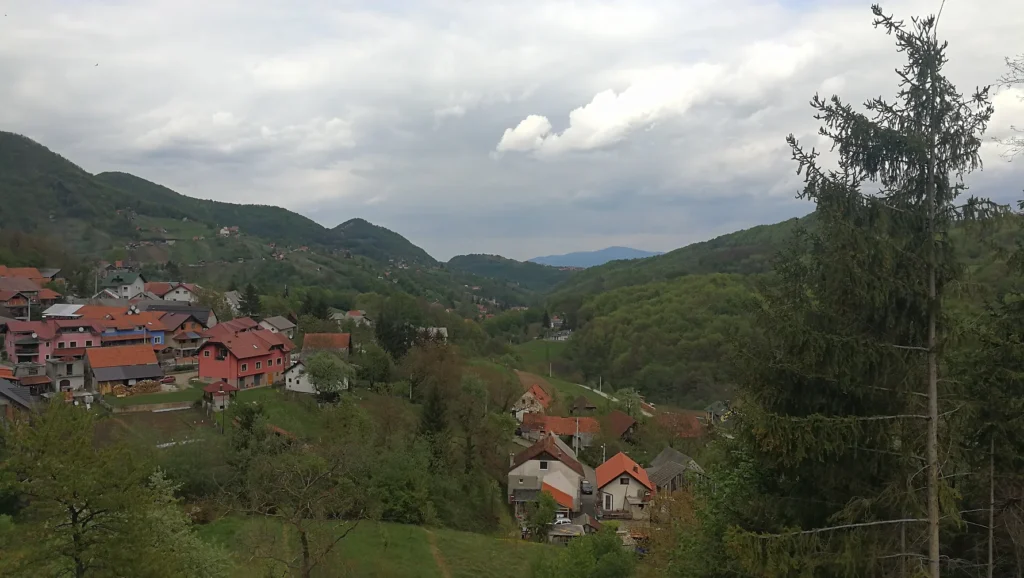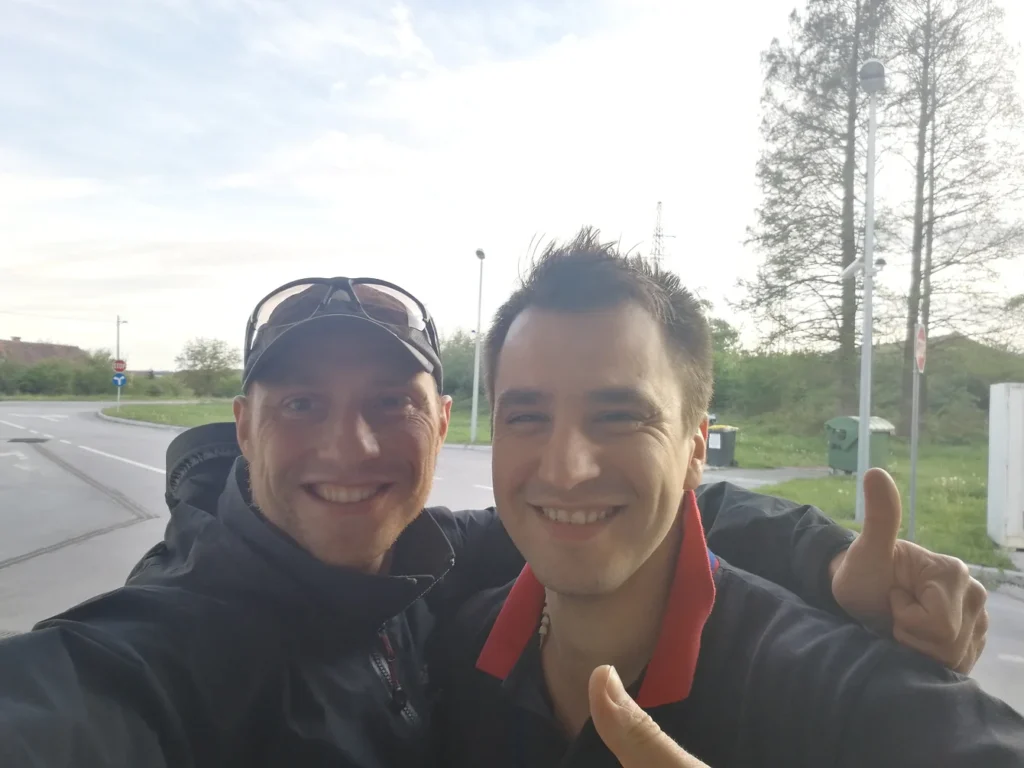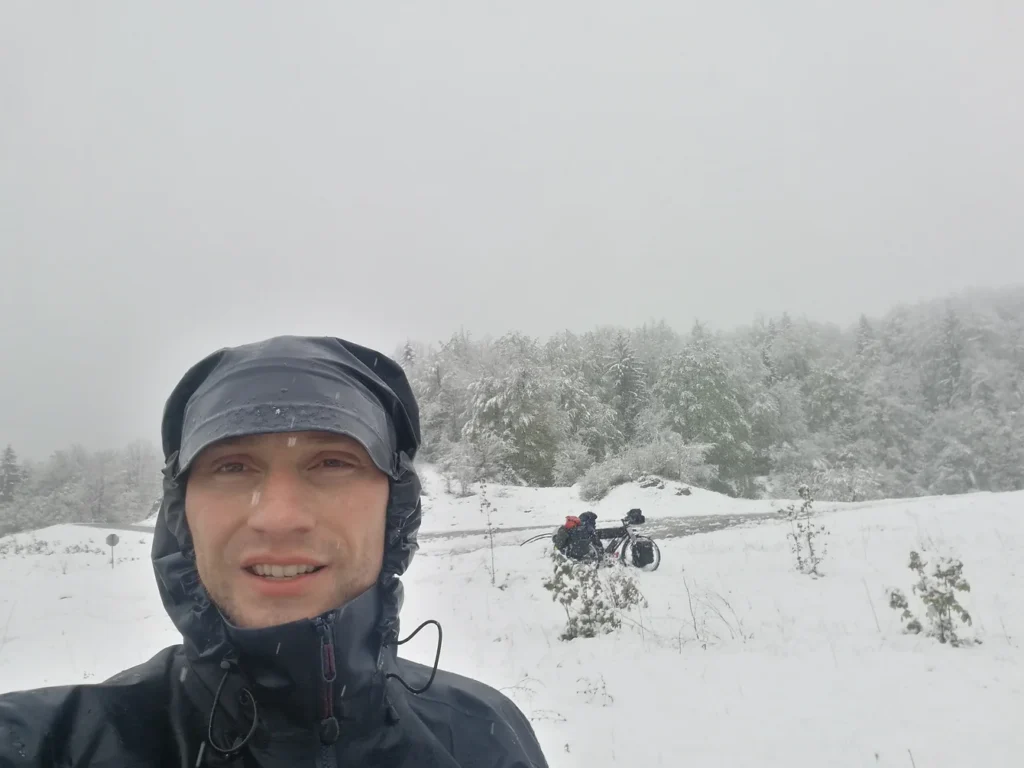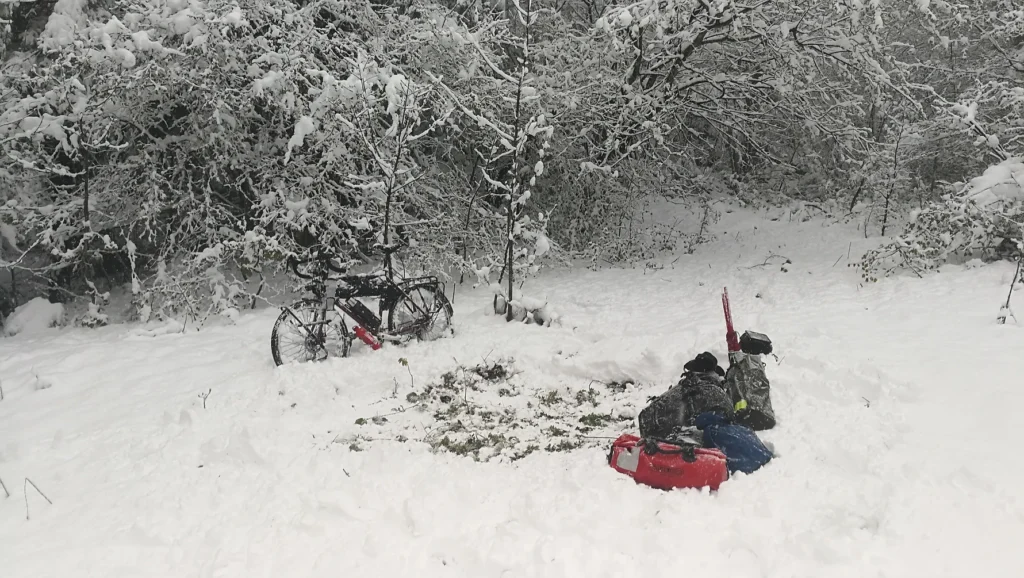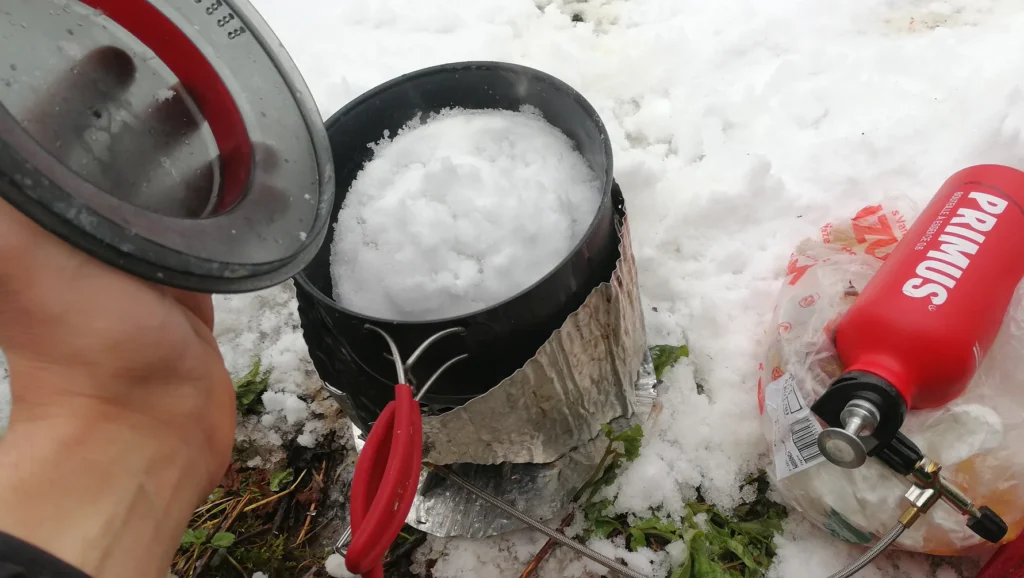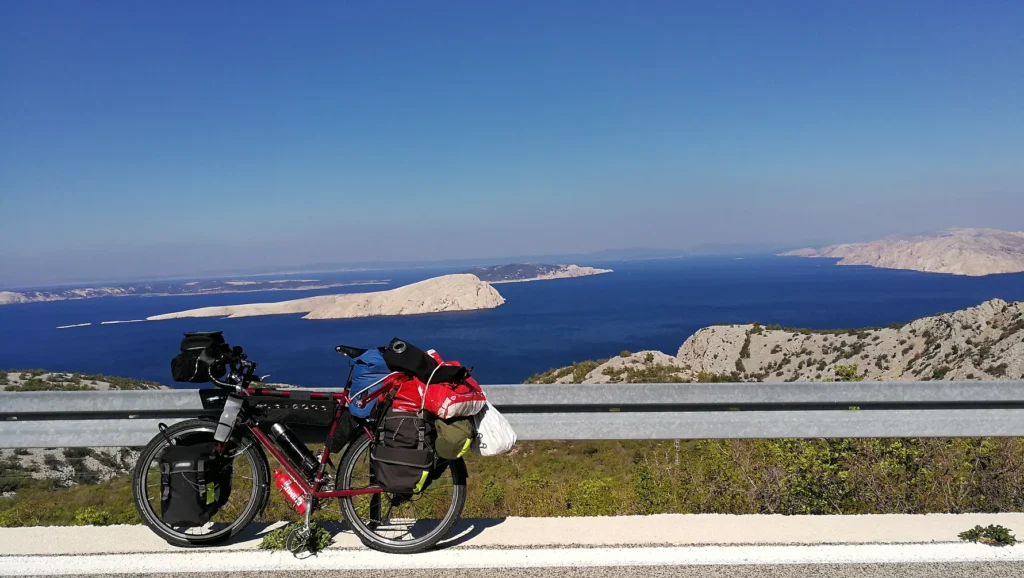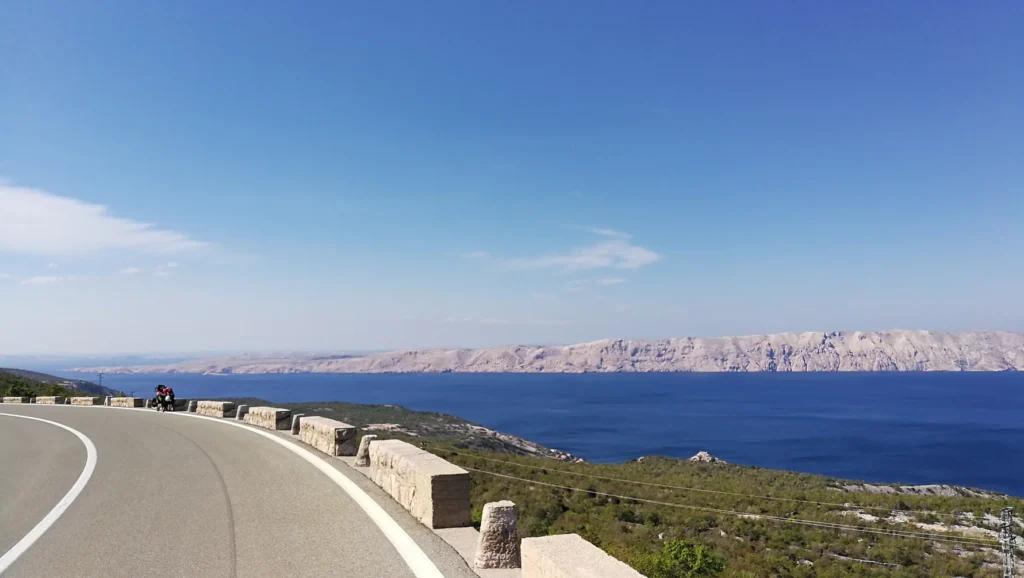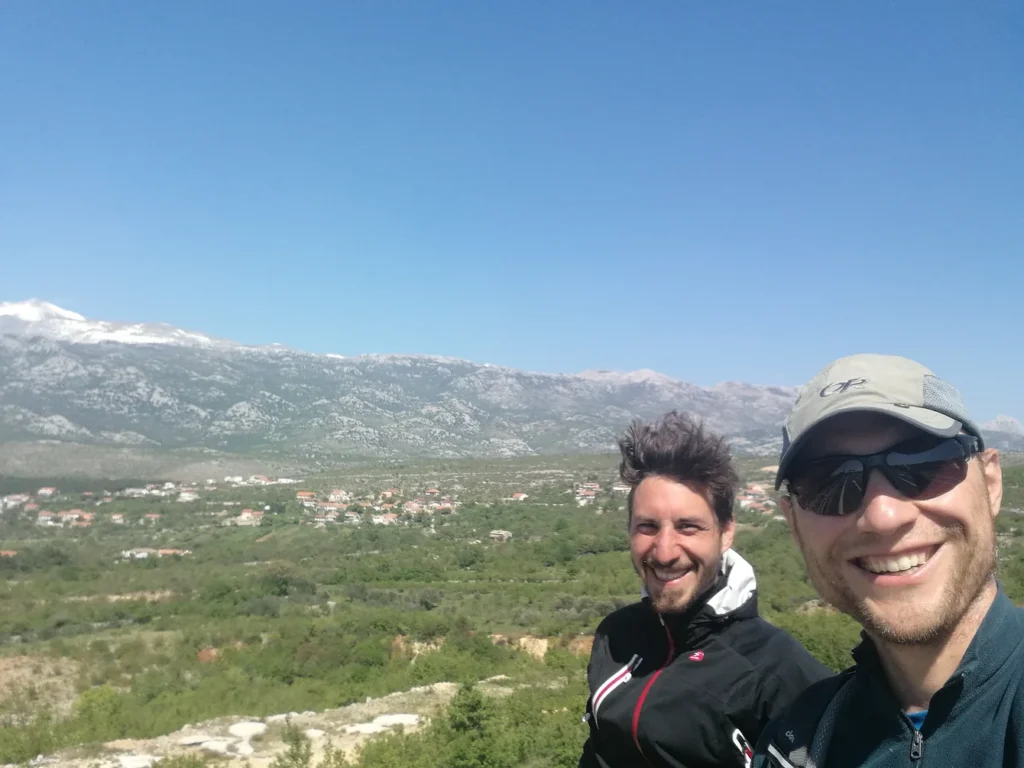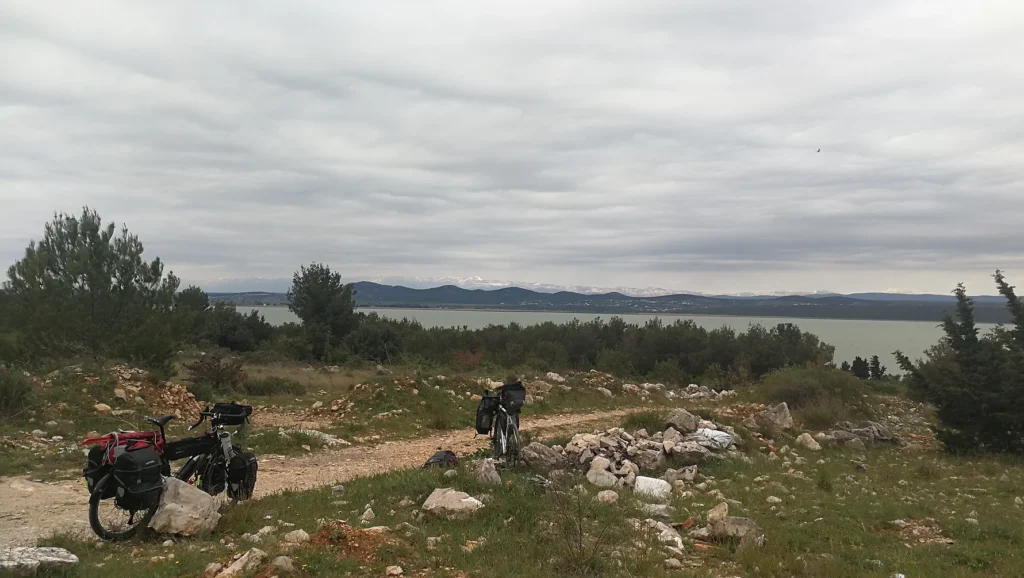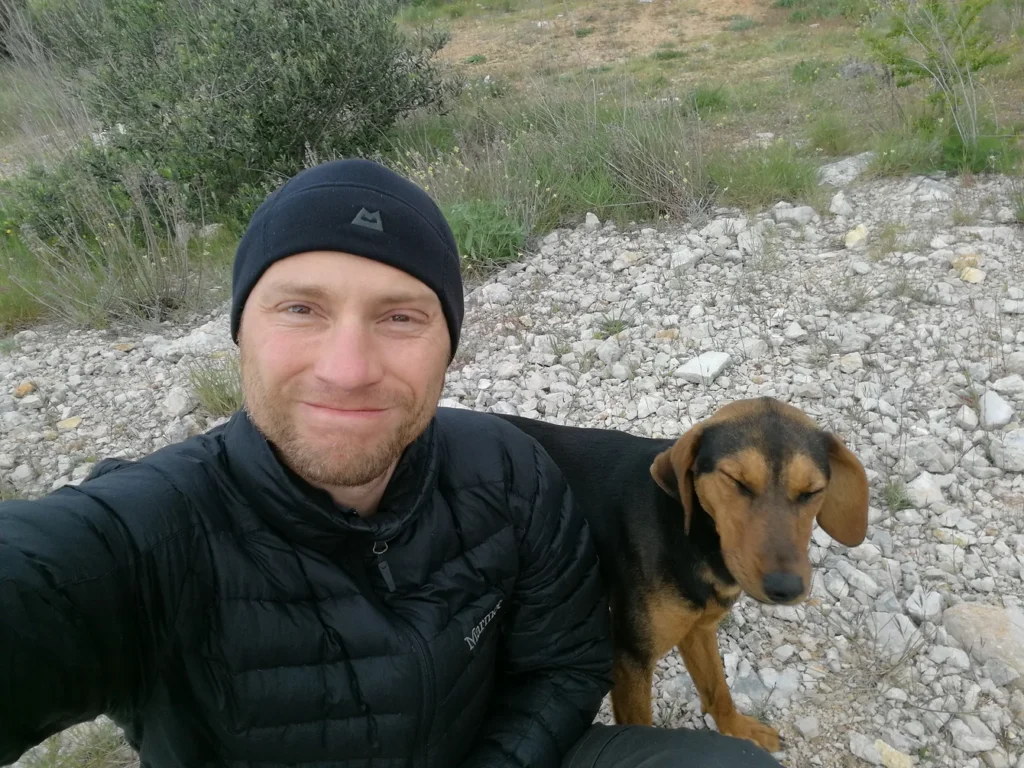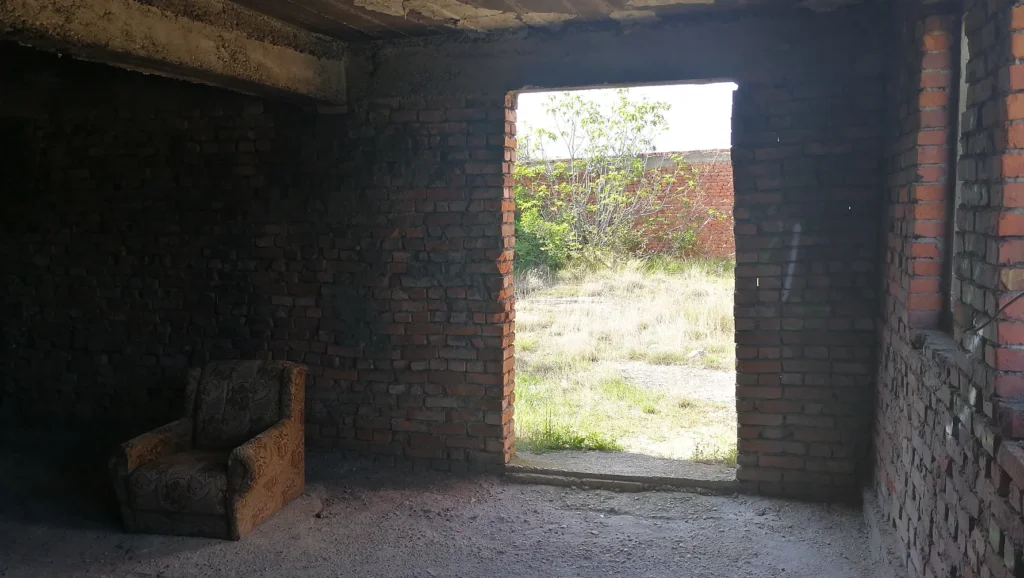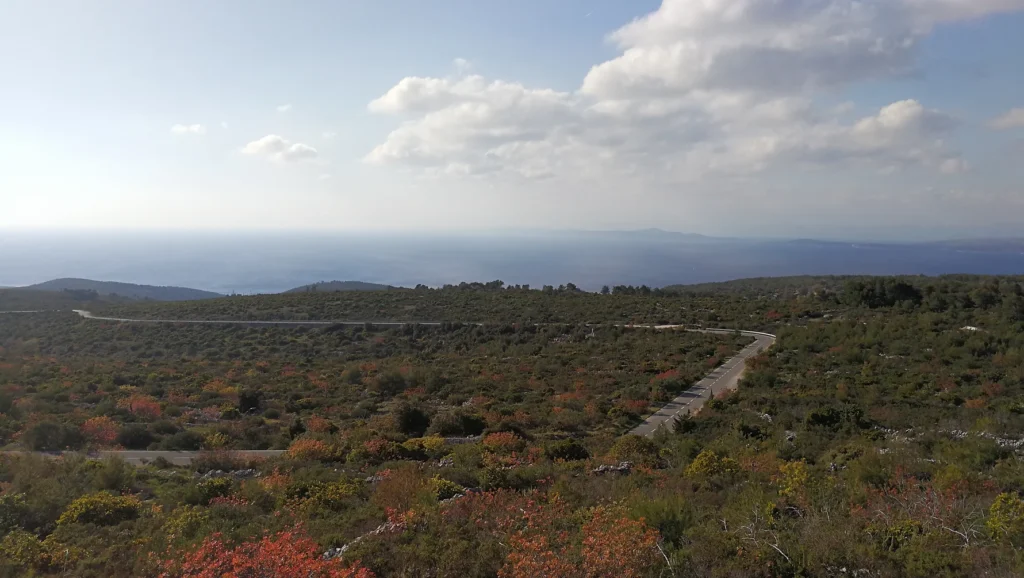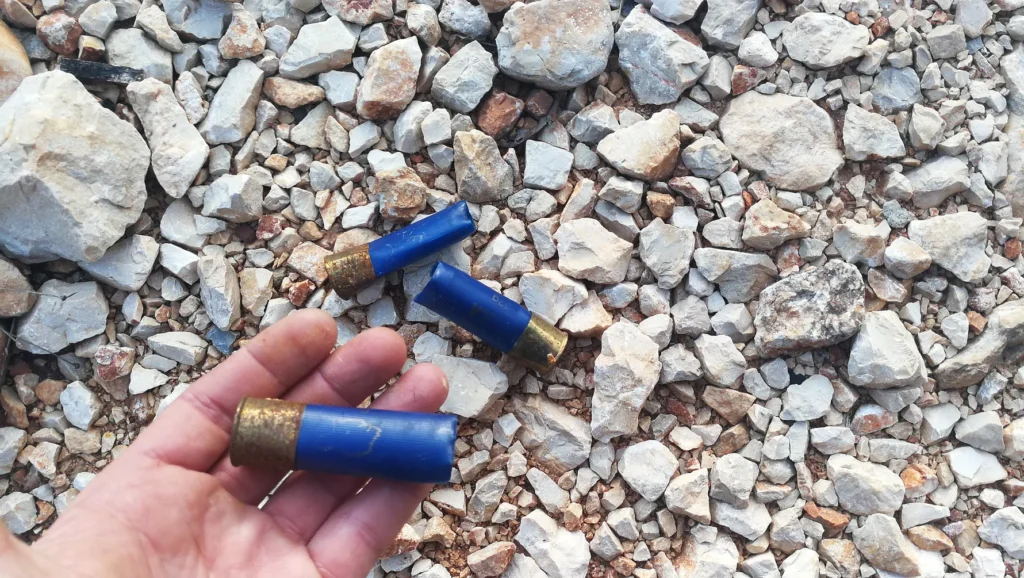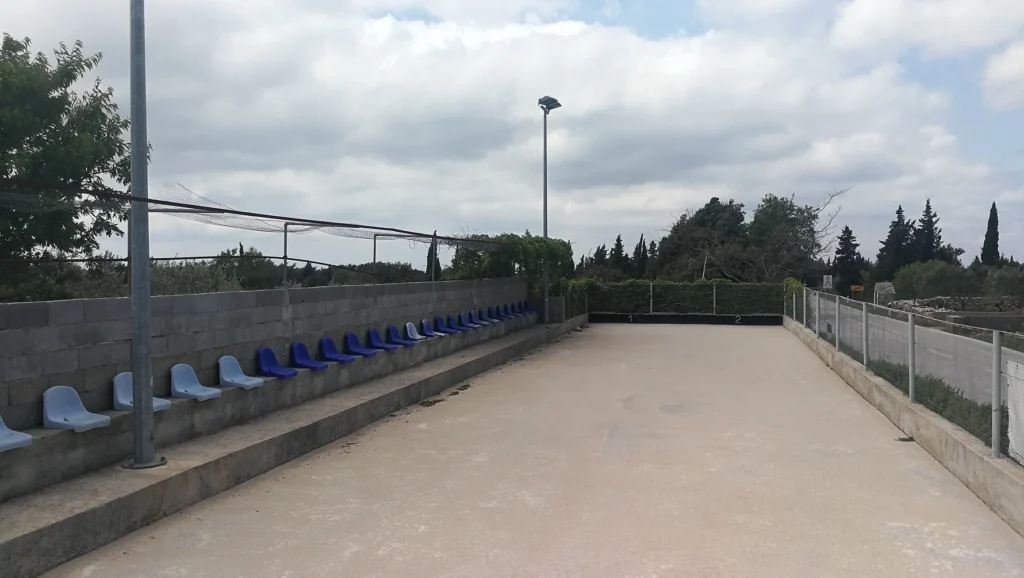Croatia — Now
I reached the Slovenian-Croatian border at noon. This was the first border crossing with a check point as I was leaving the Schengen area – meanwhile Croatia forms part of it and has no more border controls with other EU member states.
My skin said I needed sun cream and to my surprise a big supermarket was open despite Easter Monday. I stocked up on food but they didn’t carry any sun cream at all – in a large supermarket in Croatia? Sometimes I don’t understand how supermarkets work but whatever.
Once in Croatia I had the Adriatic coast within a day’s direct cycling range but decided to first cycle a loop through the Žumberak and Samobor Mountains. How would the vegetation there look like?
Cycling up the mountains I noticed that just like in Slovenia many people keep corn stored outside in mesh wire boxes. What’s the purpose? What percentage of the corn is eaten by mice?

The Žumberak and Samobor Mountains have been continuously inhabited since prehistoric times according to numerous archaeological findings. What traces will you and I leave on this planet to be discovered by future archeologists?
Coming out of the mountains, I stopped for a well-earned coffee in Draganići where friendly locals introduced me to the Croatian art of “Kava sa slagom” – which is coffee with as much whipped cream on top as is physically possible.
In Karlovac a helpful gas station employee filled my water bags, bought me a bag of crisps, and told me all about the Adriatic coast: ice cream costs 5x in Split what it costs locally in Karlovac but in Split they have the most beautiful girls.
Croatian gas station always have loud music playing outside I was told – he was surprised that’s not the case in Germany. What a great idea! Loud music at gas stations is lively and friendly and if I would open a gas station in Germany I would introduce this cultural element too.
In the evening I searched a camp spot in the forest southwest of Karlovac. I first cycled into something like a military zone so I turned around and went to another forest where I found a camp spot just before it got dark.
In the morning I packed up camp in cold and wet conditions.
Heavy rain all day plus further temperature fall. I cycled mostly through remote areas without any other people.
A sign finally announced “Cafe Bea in 500 meters” but it turned out to not exist anymore. Luckily there was a restaurant coming up but it turned out to be closed.
I studied my map and headed for a gas station. It turned out, Werner Benz gas station hasn’t sold any supplies to anyone for quite some time.
I took a piss and couldn’t properly close my zipper as my fingers malfunctioned from the cold. In such situations it really pays off to have a thermos bottle and having it filled with boiling water in the morning after breakfast.
I made myself a hot coffee, ate a cereal bar, and thought about acceptance.
Since starting in Berlin I realized that a bike tour requires the rider to operate in the here and now most of the time. A bike tour is a constant stream of decisions around cycling, navigating, eating, camping, and weather handling. And these jobs need to get done first before there is space for philosophical musings – not falling of the bike requires a certain mental presence in the now.
I cycled into the mountains. The day before I had been searching sun cream with visions of Croatian beaches but it turned out the temperature fell more and more. I wondered what took the snow so long on this tour to show up … I’ve been ready for a long time.
Now is the moment we all live our lives. Not in the past, not in the future, we breath in and out and take action in the now.
Whether we think about our “language”, “body”, “values”, “emotions”, “blockades”, or about “integration” – this thinking always happens in the present moment. And perhaps more important, we exist and feel and act always in the present moment.
When else should we exist and feel and act if not in the now?
I pitched camp with enough daylight left to collect firewood and set up the tent dry and cozy. The fire served as a deterrence for the very unlikely but possible bear or wolves pack coming by and also radiated some heat into the tent.
The cold has some effects to consider. The olive oil gets solid, the honey doesn’t come out of it’s tube, the water filter must be protected from freezing, but all no problems – I simply took those items and my electronics into my sleeping bag.

I filled my drinking bottles with warm water and camp-showered. When camping there is always this one moment after dinner, teeth-brushing, peeing, and closing the sleeping bag when you breath in and nothing else remains to be done for the day. When you breath out and let it all go with a smile.
Now is the moment we feel our emotions.
When we are mindful of what’s going on in our consciousness. When we are present in our body.
When we listen deep. When we are our unique self and authentic. When we are honest with ourselves and brave.
It’s our individual life path which we feel. Our true feelings are always there inside us whether we listen to them or not. But when we feel them we always feel them in the now.
When our consciousness attention is in the now, it is not focused on another time.
When our consciousness attention is in the here, it is not focused on another place.
But not just that – when our consciousness attention is in the now and here it is both empty while perceiving the present fully.
The now is pretty safe. Usually we don’t really have problems in the present moment, at least no existential ones. That wolves or bears come and eat us is very unlikely.
Now is the moment we can trust ourselves. Now is the moment we can trust the biological life pulsating through our body.
Now is the moment we can give ourselves compassion. We all are doing a great job breathing in and out and we will keep breathing – our vital body functions are reliable.
The now is peaceful and calm, even in a storm.
Now is the moment of action but also the point in time when we can decide to not take any action mentally. To do nothing, to be cognitively silent, to simply exist and feel.
What are you feeling right now, dear reader?
Snow has several advantages: it’s pretty, it bounces of equipment/cloths (vs. rain soaking things), and with enough fuel to melt it snow provides an unlimited water source. Also, snow makes the environment calm as it absorbs all noises.
Being in the now helps us to live deeper. And when we have a calm consciousness and our cognitive voice is dimmed, we become more receptive to how we feel.
The self-help teacher Eckhart Tolle points out how powerful the concept “Now” is:
“What is the power of Now? None other than the power of your presence, your consciousness liberated from thought forms. So deal with the past on the level of the present. The more attention you give to the past, the more you energize it (…). Give attention to your behavior, to your reactions, moods, thoughts, emotions, fears, and desires as they occur in the present.”
So when you and I as breathing bodies with values and emotions try to better understand our consciousness, when we try to go deeper inside us, a helpful ingredient to move forward on our path is consciousness attention to the now.
But more an already present attention which we re-find in our consciousness – less an actively chosen attention which we would “do” from the perspective of us as an “active” individual.
The sun came out and it was time to stop the meditation, pack up camp, and cycle to the Adriatic Sea.
When I started cycling the snowfall came back. After 1 hour I reached Kapela pass, then I rode a long and cold downhill.
In the first little mountain village I stopped for a coffee in a small bar. There are many rumors about bears and wolves in the Balkans but in that bar I met a reliable source: a bear hunter.
He told me about his camera traps and luring bears with cabbage. When the right bear is in the area he calls hunting clients from Austria but by the time they come down to Croatia the bear is often gone. Because when the bear is there, the bear is there now.
The bear hunter bought me a coffee – great stories and very friendly locals. Thank you – Hvala!
I cycled further downhill and called it a day some kilometers north of Senj, pitching camp at an abandoned road.
Now is the moment we can feel our emotions with trust.
Trust other people who usually help us and are rarely evil.
Trust ourselves as we humans are a biological wonder of nature with many advanced abilities to solve problems.
And trust life in general. When we relax and let go of our reflex to try to control everything, we experience that our life is always there carrying us forward.
Check your pulse – you are not just a mind, but a living life form with a pulsating heart!
Observe your breathing – it is always there for you.
In the now, we can feel our emotions and integrate our emotions naturally … as a breathing body with a consciousness.
I was told it’s all downhill from Kapela to the coast but it never is all downhill. I cleared another small pass (Vratnik), passed some farmer houses with self-made honey and cheese offered on small tables by the road, and then there it was – the first view of the Adriatic Sea. Having cycled here from Berlin touched me inside.
In Senj I bought food supplies which in retrospect was a good decision – off-season there are zero supply options from Senj to Karlobag and riding that stretch in the wind is tough.
I pitched camp at the most wind protected spot I could find – at night the Bora wind kicked in with full force. This is an accurate description: https://en.wikipedia.org/wiki/Bora_(wind)
The wind got so strong that I hardly slept all night – it’s surprising how loud it is in a tent being shaken by wind gusts.
How do our fears work? No matter the external conditions of cold, heat, or whatever – I always feel safe in nature and I also felt safe sleeping here in the storm. But internally, I carried emotions which were scaring me.
The next morning the Bora wind was still there. I later learned from a local that the Bora wind usually comes 1 day, stays 1 day, and leaves 1 day.
Last night my tent in a semi-protected camp spot was moved around despite my bike bags inside. How would cycling be today?
The Magistrala, the old road along the Croatian coast, is considered by many people one of the most beautiful coastal roads. It offers a spectacular ocean view along the entire Croatian coastline. Most of the time there are large islands visible close to Croatia’s mainland shore.
The views were stunning but the intensive blue and sun did not mean warm at all: the winds coming down from the Velebit mountains were strong and icy.
The Magistrala mostly runs at about 200 meter elevation. I dropped down the the little village Stinica directly at the shore with the hope to find a restaurant and get a break from the wind.
It turned out Stinica looked pretty but was completely deserted in the off-season, nothing alive here. This was strenuous 2h return trip from the Magistrala which made me at least wiser.
At Croatia’s Adriatic coast there are surprisingly sharp stones everywhere, probably formed by erosion. The sharpest stones I have seen in my life. This area generally felt a bit like a desert but perhaps my judgment was biased by the windy cycling conditions which take a mental toll.
The Magistrala runs along the edge of Northern Velebit National Park – home to bear, wolf, and lynx. In its highest area the park has more than 50 peaks above 1600 meter, all erosion-rugged karst rock formations. How would hiking up there be like?
In the afternoon I met the first other bike tourer on my tour. He had also started in Berlin but had taken a quite different route to the Adriatic Sea.
Together we cycled long into the evening making it a 130 km day. It’s fun to cycle with someone else – you can chat and do slipstream cycling.
We pitched camp south of Paklenica National Park and chatted late into the night about bike touring philosophy and life.
In the morning we packed up camp, got water, and cycled south.
After more than a month alone on the road, cycling together was a change – conversations, listening, exchanging ideas. It felt good to leave my consciousness bubble for a while.
We cycled a similar speed following the Magistrala south. In Jasenice we turned south-west past a large lagoon in order to stay directly at the coastline.
Would you bungee jump from a bridge?
I’m sure it feels very much like an experience in the now.
My cycling friend had a small bike issue and wanted to find a bike mechanic to have a look. We therefore decided to cycle into Zadar, the oldest continuously inhabited Croatian city founded around 3,000 years ago.
In Zadar we met Bruno, a local bike mechanic and ambitious downhill rider. He told us with a group of friends he created a downhill course in the mountains – on the weekends they get a group of cyclists in a van driving them up, then they race down together. Sounds good!
Bruno invited us to a live music event in the evening and we decided to stay in a downtown hostel to join him and his friends. This was the first time I paid for accommodation since starting in Berlin 5 weeks ago and it was a good investment – I’m a big fan of nature and wild-camping but sometimes it feels good to connect with people.
The next morning we restocked food in a Pekarna, then it was time to cycle south towards Split.
Today we saw several people collecting wild asparagus. Inspired we tried finding some ourselves with dinner upgrade visions but without success.
Over the course of this afternoon the landscape changed from rough stones to olive trees – Croatia produces some of the finest olive oils in the world.
In the evening we found a great camp spot overlooking the bay of Šibenik. Sharp stones, I got a cut when I explored the steep shore.
To “live more in the now” – what does that mean?
Consciousness attention on the now does not imply a chosen mental activity. The more we “choose” to do something like “focusing on the now”, the more we limit our ability to listen to our emotions and discover new things inside ourselves.
The Zen monk Shunryū Suzuki put it this way:
“In the beginner’s mind there are many possibilities, but in the expert’s there are few.”
When we look at our life with many preconceptions we are less receptive, less able to experience reality deeper. But when we practice a beginner’s mind we become a person open to new consciousness discoveries, including our feelings.
A beginner’s mind in the now, being open and receptive to feeling the deepest emotions in my consciousness – this is what I wanted and I was committed to go this way whatever it took. The tricky part was that this probably required overcoming the “I” and “want” part inside myself to get there. But many other people have done this too, so it should definitely be possible with practice. How difficult can it be?
I looked at the blood on my hand and smiled. Had I been more present when exploring the shore, I may not have slipped and therefore I took the cut as a gentle reminder to live more in the now – thank you cut-in-my-hand.
When was the last time you tasted your blood?
At night Šibenik bay was calm as a mirror and full of light reflections from the city. We lost some food to a young dog coming out of nowhere chewing on everything outside our tents.
In the morning a school of dolphins crisscrossed the otherwise flat bay. Do you think they have a consciousness?
All this thinking about consciousness – was it perhaps all a big self-made hurdle of escapism from the now? Did I hide behind endless intellectual considerations instead of just being brave enough to let my feelings fully arise?
I disinfected the cut on my right hand and decided to cycle more with my left hand in the days ahead. What I really like about bike touring is that overthinking things is automatically limited – you have to keep moving forward to get somewhere.
My cycling fellow from Berlin and I split up as I wanted to go slow to protect my hand. In the morning I rode in easy terrain but decided to skip the mountains before Split. In flat terrain I didn’t need my right hand much but in the mountains I have to grip the handlebar tighter and also sweat more which may not be ideal for healing.
On my map I saw a train station close-by and decided to try to take a train from there into Split. At first I didn’t find the station as there was no real way leading to it …
… and Ripište train station also didn’t seemed to be used that much these days …
… but in the end the station was functional. With hand signals I stopped a train and after 1 hour riding through the mountains we arrived in downtown Split where I stayed in a hostel.

The next morning I looked at all my equipment critically as I wanted to carry less. At the end I went to the post office and send a surprisingly large package home with equipment and cloths I rarely used or was willing to simply do without. Just like in Budapest where I had left a lot of equipment behind, also now I immediately felt more free. Everything you possess also possesses you.
In the afternoon I took a speedboat to Hvar, an island on which I cycled 80 km parallel to the mainland coast. Bikes were normally not allowed on the speedboat but there was space and the captain agreed that I can bring it if I buy 2 tickets.
Hvar is an island rich in history – it is one of the sunniest of all Mediterranean islands with perfect conditions for Lavender production.
I restocked food on arrival and due to the windy conditions decided to cycle an inland route.
In retrospect taking the speedboat to Hvar (the island and city have the same name) and cycling the inland route were good choices as I saw almost zero traffic over 2 days on Hvar.
The small towns in Hvar radiate a dreamy traditional feel. How could anyone be stressed here?
Archaeological findings showed that the island had already been settled by the end of the stone age 5000 years ago and later by the Greek and the Romans. In 1992 the war in Bosnia and Herzegovina send many refugees to the island and the small airstrip on Hvar got bombed twice.
In the evening I found a great wind-protected camp spot in a stone quarry:
The wild boar on Hvar better watch out because someone has trained shooting.
This was a great cycling day – I was also happy how fast my hand was healing.
Now is the moment we are healing.
When our physical body heals, we don’t feel the healing process itself and we don’t need to consciously activate it – physical healing happens naturally and functions well. Is there a similar healing process in our consciousness?
When we have physical wounds our body reacts with blood clotting (to prevent blood loss), inflammation (white blood cells doing cleaning), and new tissue growth. Isn’t that simply amazing, this capability of our body to heal itself?! I am grateful for it.
The spectrum of consciousness experiences we make is diverse so a simple comparison of “physical” and “consciousness” healing is challenging – also because we can’t observe consciousness healing processes externally, unlike a cut hand.
What is a “consciousness wound” in the first place? Is it something like an emotion of pain, anger, or fear which we suppress in our subconsciousness?
I don’t know how the human consciousness works but I believe we all have a disposition for natural consciousness healing similar to physical wound healing.
Of the infinite number of examples we could consider, here is just one: when we get hurt by something someone said to us and later we forgive and generate compassion for the other person and ourself, then our pain and anger naturally dissolve.
But despite the similarities there are also major differences between physical and consciousness healing, as consciousness healing processes are much more profound in our existence.
Feeling: unlike physical healing processes, we can observe and feel our consciousness healing processes when we pay attention.
Learning: unlike physical healing processes, we can learn from consciousness healing processes, for example by adapting our personality and how we treat ourselves and others.
Influence: unlike physical healing processes, we can actively influence our consciousness healing, for example by the articulating values we want to live by (e.g. “forgiveness”), followed by a sincere execution.
Isn’t that simply amazing too, this capability of us to heal our consciousness and to actively participate in our healing?! I am grateful for it.
Feeling, learning, influence – do you think our “consciousness healing” works better when we are more in the now?
Today I rode 60 km on the island and another 40 km on Croatia mainland. Hvar feels French, for example I saw a boule place and the few cars here are often Peugeots. Perhaps due to Napoleon’s short rule here or due to Hvar’s lavender exports for France’s perfume industry?
I cycled past three man putting new branches to old olive trees – they looked focused like heart surgeons.
How does our consciousness connect to nature?

Do humans control nature or does nature control us? Or are both linear perspectives naive as we are an embedded part of nature in a complex web of interdependencies?
Albert Einstein wondered if he believed in Pantheism, the idea that everything that exists in the universe is god. If god is everything that exists – all matter and energy and realm and time across the entire universe – then god is logically also nature and our consciousness simultaneously.
Perhaps one reason why we run into barriers of language is that our cognition operates with a limited worldview. Since our birth we are continuously trained by our surrounding reality to understand the world based on classical mechanics. We therefore automatically assume that some things are universally true, such as fixed boundaries of physical objects and linear time.
But modern physics has shown that there is a world of quantum mechanics underlying the directly perceivable world of classical mechanics (e.g. A Brief History of Quantum Mechanics – with Sean Carroll).
Perhaps our consciousness and nature are interwoven in various ways we can’t access with our limited cognition?
Perhaps we can perceive more by feeling into the now?
I left the olive tree meditation behind and cycled further east. The landscape changed from a Mediterranean to a jungle feel.
Compared to the western part, Hvar’s eastern part is wilder with almost no cultivated land or towns in sight. Along its entire length Hvar is surprisingly hilly – the highest elevation St. Nikola peak rises 628 meter above sea level.
At Hvar’s east end, Croatia’s mainland is just 4 km away. There the coastal mountain chain rises steeply up from the shore to over 1,000 meter elevation which looks spectacular.
I really liked Hvar – great nature, and the people here seem to know how to have fun.
I raced the last downhill to Sućuraj in one go and arrived full of adrenaline and joy at the ferry back to mainland Croatia.
Croatia is definitely a cool place – diverse, stimulating, making you feel alive.
Breathing in, breathing out.
Fuck yeah, life feels good in the here and now!
After a short ferry ride we arrived Drvenik, a small fishing village at the bottom of the Biokovo mountain range. These mountains have an exceptionally high biodiversity in plant and animal species.
Back on the mainland I cycled south along the shore until Ploče, then I waved the Adriatic coast goodbye and rode east towards Bosnia and Herzegovina.
At the last Adriatic coast viewpoint, I sat for a while and wondered how “being more in the now” really works. What’s your perspective, dear reader? You probably know this as well as me.
In my view, being more in the now requires different consciousness ingredients for different people at different phases of their lives – every human biography is unique so I believe there can’t be general rules. The things standing between your current consciousness state and the now are different from mine.
I’m just a cyclist and I don’t know much about the human consciousness. Many people smarter and more literate and more experienced than me have articulated thoughts on “being in the now” with clarity and wisdom – I can only share some subjective ideas based on my gut feeling, things that have worked for me.
Of the million things which could be discussed as consciousness ingredients helpful to be more in the now, for me the following three have been particularly effective.
Self-compassion: Similar to integrating emotions, also being more in the now seems to work better with self-compassion. I think that’s because self-compassion is key to accepting all parts of us – and to stop fighting ourselves makes us calm.
When I felt far away from “being in the now” and my consciousness attention was racing all over the place, I started practicing compassion for the fact that I’m human and it’s ok and normal to often not be in the now … which worked great to calm me down.
And the mental trick to regard myself as a loved friend (which many people before me have written about), this trick is super-powerful and effective in my experience. A loved friend you simply treat with compassion and understanding no matter what happens, right? I realized that being reliable and there for myself in a loving and caring and supportive way was the key both for my emotional integration … and to go really deep inside my consciousness.
Concentration: I think “being more in the now” is a game of concentration, of sensing our feelings, body, thoughts, and surrounding reality fully in the present moment.
On the one hand, concentration seems to be question of dosage as with everything in life – too much (forced) concentration makes us stiff and less receptive. I generally believe we progress best on our consciousness journey through life when we stay in a concentration zone that’s relaxed.
On the other hand, concentration is something we don’t really practice a lot these days – and too little concentration may mean we don’t capture important things in our consciousness (e.g. our feelings) and when we do, we stay shallow as we don’t take the time to stay with and integrate what we perceive.
On this tour I went largely offline from the beginning. After about 1 month I lost the impulse to check my email (which I had done daily in my life before). After about 3 months my concentration was orders of magnitude better than before … I simply felt calm and good being in nature.
While concentration can be directed on anything, I realized that concentration on the now, in particular how I feel now, was a key consciousness ingredient helping me grow. Sure we can sometimes “learn” from the past. Sure we can sometimes “imagine” the person we want to be in the future and back-translate this into steps we need to complete to get there. But given that we always become who we are in the now, a focus on how we feel in the now seems to be a constructive consciousness attention calibration. Nothing new here, a million smart people before me have explained this better – I’m just warmheartedly confirming that this really works.
What I find great about concentration is how quickly it improves … it somehow seems to work like a responsive muscle growing stronger each time we use it. And concentration does not only bring us a stronger meditative stability, and a deeper and clearer self-reflection for ourself – it also benefits others as practicing concentration improves our ability to listen to and feel into other people as well.
Acceptance: Even when we practice self-compassion and concentration, I believe things may remain suppressed in our subconsciousness until we really accept them, for example emotions we are afraid of.
When I felt far away from “being integrated and calm in the now”, I started embracing exactly this. I started practicing compassion for the fact that I’m human and that it’s ok and normal to have things like emotions I haven’t accepted yet – which worked great to actually accept them.
While I believe sometimes we need to fight and stand our ground in life, for example to defend values we believe in – non-aggression usually seems a good start into situations as it frees up our energy and lets us see our options clearer. If we are in life situation A, neither being against the given situation A nor wishing to be in another life situation B, are two complementary sides of acceptance and non-aggression.
In my view, a universal acceptance of life does not mean passivity or resignation at all. It means we start by accepting how things honestly are and then making the best of it with situational ownership – acceptance makes us active and powerful.
Acceptance avoids creating unnecessary suffering and this powerful consciousness ingredient is always there for us in any given life situation. Practicing acceptance means we avoid judging and trying to change things overly fast – even when we want to change the world it’s usually beneficial to first look at the world as it is in the now to better understand our options, before jumping into action.
Of course acceptance comes only after several other consciousness ingredients in an archetypal chain of events. For example, perhaps we need to first have a desire to heal, then search our pain, then find our pain, and only then we can accept it and grow.
But given that our emotions seem to float around our (sub)consciousness like multidimensional clouds interwoven in many layers of complex dependencies, who knows what’s true? I believe with any “linear” statements regarding causalities among things in our consciousness we have to be careful.
In Ploče I waved the Adriatic coast I final goodbye, then I rode east towards Bosnia and Herzegovina. Perhaps I had meditated a bit too long in the afternoon as I ended up cycling into the dark and only found a semi-shitty camp spot southwest of Rogotin.

There is a risk involved in thinking about being in the now and our consciousness – the risk is that we can be “stuck in thinking and theory” while our life ticks away.
The Buddhist monk Thích Nhất Hạnh taught that living fully in the now is what’s truly important in our life, not words or concepts trying to describe parts of our consciousness journey:
“Many of us have spent our whole lives learning, questioning, and searching. But even on the path of enlightenment, if all we do is study, we’re wasting our time and that of our teacher. This doesn’t mean we shouldn’t study; study and practice help each other. But what’s important is not the goal we’re seeking – even if that goal is enlightenment – but living each moment of our daily life truly and fully.“
Whether it’s Eckhart Tolle’s teachings on the power of now, Shunryū Suzuki’s teachings on the beginner’s mind, or Sean Carrol’s teachings on quantum mechanics – all such valuable and wise words need to eventually be left behind to be fully in the now. To directly feel our emotions and live our life fullheartedly.
Words are not roadblocks, they are a rite of passage. From our birth to our death it’s a natural process to develop our language and cognition and to think about our consciousness in words.
But at some point we need to graduate from words. On the one hand, to bring the wisdom of words into action (which can happen while we sit still, for example when we focus on giving someone affection and truly mean it). On the other hand, to listen to what we can feel beyond words in our consciousness – if we choose so.
Do you love your family, friends, and community? Have you already showed them your compassion today?
Have you already loved yourself today?
Your life is passing now.
In the morning I cycled over a bridge spanning the massive Neretva river. It starts high in the Dinaric Alps in Bosnia and Herzegovina and is considered the coldest river of the world.
The Neretva river flows into the Adriatic sea and its massive delta is a hotspot for biodiversity, kitesurfing, and mandarine production. This region also attracts many artists to towns like Opuzen, famous for an annual street art festival.
Croatia, thank you for bringing me more into the now. On our further consciousness expedition, let’s keep an attention on the now … feeling alive, living deeper … that kind of thing.

